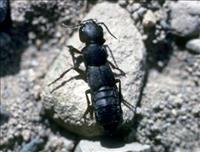|
|
|
|
|

Caption: Rove beetle
Photo by: Art Antonelli
|
|
Rove beetles
(revision date: 7/14/2015)
Use Integrated Pest Management (IPM) for successful pest management.
Biology
Rove beetles are common insects in the yard and garden, and may sometimes be found in homes. The many species come in a wide variety of forms, but most common rove beetles are slender, elongate beetles ranging in size from 1/4” to one inch long. They are often shiny or very slightly hairy in appearance and range in color from brownish to black. The most distinctive characteristics of rove beetles are their short, squarish wing covers (elytra) which leave much of the abdomen exposed and their habit of raising the abdomen in the air, scorpion-like, when threatened or running. At first glance, rove beetles may be confused with earwigs, but lack earwigs' long cerci or pincers on the tip of the abdomen. Rove beetles also often have large heads and prominent mouthparts. These are active insects, often running rapidly or flying when disturbed. Both adults and larvae may be found on plants or mushrooms, in decaying plant litter and debris, under stones, associated with ant or termite colonies, or near dung or carrion. Adults of some species may be attracted to lights at night. These insects have large, strong mouthparts which can inflict a sharp bite or jab. Rove beetles should not be handled bare-handed because some species produce toxins which can cause a localized allergic skin reaction. Most species of rove beetles are predaceous or scavengers and are considered beneficial.
|
|
|
Management Options
Non-Chemical Management
- Outdoors, no control of these insects is necessary.
- Indoors, if they become a nuisance, rove beetles may be removed by sweeping, vacuuming, or capture and release outdoors.
- Openings around doors, windows, and foundations should be closed off or adequately screened to prevent the rove beetles from entering the dwelling.
- Recurring problems may indicate the presence of an ant or termite colony, animal feces, or carrion in the vicinity. In this case, the rove beetles are a secondary problem which will be solved by removal of the ant or termite nest or by cleaning up dung, carrion, etc. which may be providing a habitat for the beetles.
Select non-chemical management options as your first choice!
Chemical Management
None recommended.
|
|
Images
+ Show larger images
| |

Caption: Rove beetle
Photo by: Art Antonelli
|
|
|
|
|
